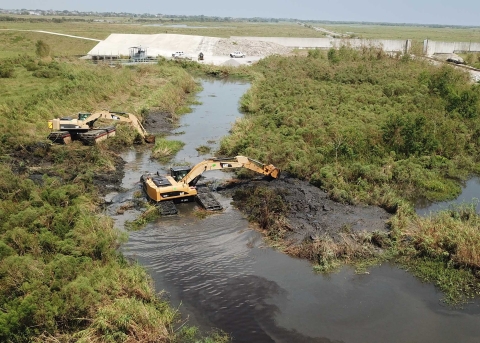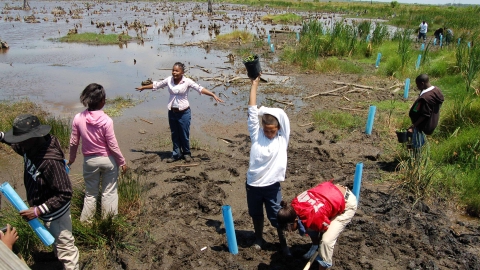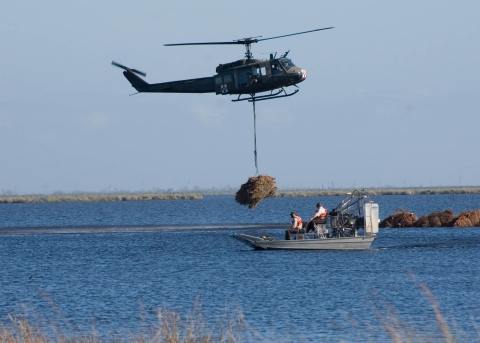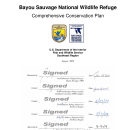What We Do
Wildlife conservation is at the heart of the National Wildlife Refuge System. It drives everything we do on lands and waters managed within the National Wildlife Refuge System, from the purposes for which a national wildlife refuge national wildlife refuge
A national wildlife refuge is typically a contiguous area of land and water managed by the U.S. Fish and Wildlife Service for the conservation and, where appropriate, restoration of fish, wildlife and plant resources and their habitats for the benefit of present and future generations of Americans.
Learn more about national wildlife refuge is established, to the recreational activities offered, to the resource management tools used. Using conservation best practices, the Refuge System manages Service lands and waters to help ensure the survival of native wildlife species. Refuge staff use a variety of resource management techniques to maintain, recover, or enhance plants and wildlife and the habitats on which they rely at Bayou Sauvage Urban National Wildlife Refuge. Prescribed burning; water management; mowing; using biological control to reduce invasive species invasive species
An invasive species is any plant or animal that has spread or been introduced into a new area where they are, or could, cause harm to the environment, economy, or human, animal, or plant health. Their unwelcome presence can destroy ecosystems and cost millions of dollars.
Learn more about invasive species ; and marsh grass and tree planting are ways we help native plants and wildlife to thrive on the refuge.
Urban and Community Engagement Program
As part of the Urban Wildlife Conservation Program (UWCP), Bayou Sauvage Urban National Wildlife Refuge is a designated Urban National Wildlife Refuge due to its location in the city of New Orleans. The refuge offers urban dwellers an opportunity to experience wildlife and the habitats that support them close to home. The Urban Wildlife Refuge Program at Bayou Sauvage Urban reaches beyond refuge boundaries and into communities to promote sustainability and equity and to provide opportunities for New Orleanians to connect with nature.
The UWCP was created to improve access to nature for Americans who live in or near cities by fostering strong, meaningful partnerships with communities. Through working with others, the refuge seeks to develop programs and projects to connect and serve our local communities. Learn more about the strategies and successes of the UWCP.
At the core of the urban program are eight Standards of Excellence:
- Know and relate to the community.
- Use stepping stones to engage people in nature.
- Build partnerships.
- Be a community asset.
- Ensure adequate long-term resources.
- Provide equitable access.
- Ensure visitors feel welcome and safe.
- Model sustainability.
We partner with many organizations to develop programs and projects with and for the community. Community partners include: City of New Orleans, Civic Studio, Common Ground, Healthy Gulf, Limitless Vistas, Song CDC, SOUL, The Urban Conservancy, UNO Coastal Education Program, and Water Leaders Institute.
Management and Conservation
Wildlife Surveys: Refuge managers conduct ground and aerial wildlife surveys and vegetation surveys to monitor plant and wildlife populations and habitat use.
Water Management: Most of the refuge is located inside massive hurricane protection levees, built to hold back storm surges and prevent flooding in the low-lying city of New Orleans. The levees interrupt natural water flow patterns and challenge refuge managers to maintain productive wetland habitats in this altered environment. A network of pumps and flap gates provides a means to regulate water levels to encourage the summer growth of emergent grasses that later provide food for waterfowl during the winter.
Forest Restoration: Hurricane Katrina in August 2005 inundated the refuge with several feet of water and severely damaged the mature hardwood forest at Bayou Sauvage Urban's Ridge Trail area. Many of the trees that remained standing, could not survive the salinity brought by storm surge. This shady mature forest of oak trees and other hardwoods had formerly sheltered neotropical migratory birds and many other wildlife species. Restoring the Ridge Trail with hardwood trees is ongoing and the song of warblers is returning.
Marsh Restoration: Each year, Christmas trees from households in New Orleans get recycled to support life in the marsh. Bundles of trees are airlifted as a National Guard training exercise, and placed in the marsh to reduce erosion.
Prescribed Fire: Prescribed fire mimics formerly naturally occurring disturbance by fire within refuge habitats. Burning at the refuge helps to maintain plant and wildlife diversity and abundance and is conducted in accordance with a fire management plan.
Invasive Species Management: Invasive species degrade, change or displace native habitats and compete with our native plants and wildlife. Monitoring and control of invasive species invasive species
An invasive species is any plant or animal that has spread or been introduced into a new area where they are, or could, cause harm to the environment, economy, or human, animal, or plant health. Their unwelcome presence can destroy ecosystems and cost millions of dollars.
Learn more about invasive species using best management practices is an integral part of refuge management. Non-native species we control include feral hogs, nutria, salvinia, water hyacinth and Chinese tallow.
Our Projects and Research
Restoration of the Ridge Project: This post-Hurricane Katrina project is restoring a mixed hardwood forest which suffered extensive damage due to saltwater and wind. Since 2005, local schoolchildren and community volunteers have been planting trees and native plants, and removing invasive species invasive species
An invasive species is any plant or animal that has spread or been introduced into a new area where they are, or could, cause harm to the environment, economy, or human, animal, or plant health. Their unwelcome presence can destroy ecosystems and cost millions of dollars.
Learn more about invasive species at this site. An interpretive boardwalk trail explores this area.
Some research activities are allowed on national wildlife refuges with a special use permit issued by the local office, and are subject to specific conditions and fees. This permit requirement is meant to ensure that all activities at the refuge are compatible with the refuge’s congressionally mandated wildlife conservation goals. Special use permits may limit the scope, timing and location of the activity, as determined by the refuge where the activity would take place. Universities, students, and other organizations wishing to conduct research on the refuge should fill out a special use permit application and submit it by email to the Refuge Manager. Please allow 30 working days to process the permit. The research special use permit is valid only when approved and signed by a refuge official.
Research and Monitoring Special Use Application (FWS Form 3-1383-R)
For research and monitoring activities by students, universities, or other non-FWS organizations.
Law Enforcement
The U.S. Fish and Wildlife Service maintains a law enforcement presence on National Wildlife Refuge lands for wildlife and public safety. Our refuge law enforcement officers protect fish, wildlife, plants and other natural, cultural and historic resources by fostering understanding and instilling in the visiting public an appreciation of refuge resources, laws, and regulations.







